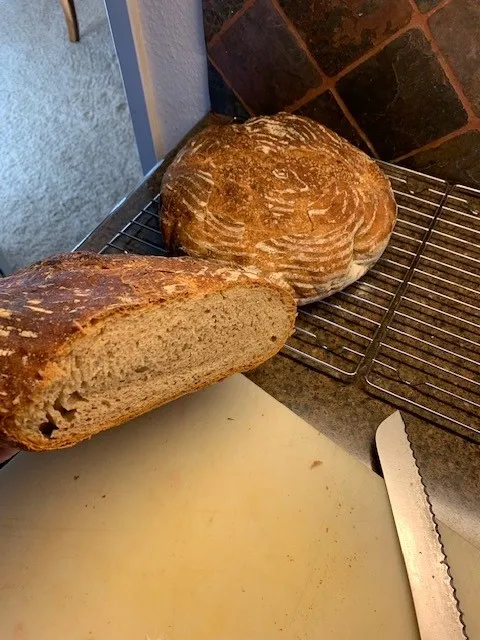
I'm a new enthusiast and have had a few successful loaves, particularly with Forkish's FWSY recipes. I always follow his instructions carefully (including water temps, etc.). But, on this 50% whole wheat loaf with biga, the loaves just didn't seem to spring up in the oven, and the crumb seems dense. I had a similar problem with the Overnight County Brown Levain recipe. The loaves taste great, but the shape and crumb lack the aesthetic beauty of taller, more airy loaves? Is this the crumb and shape one would expect for a 50% whole wheat loaf?
In terms of procedures on these loaves, I mixed the biga and it fermented overnight, rising as expected. I did three folds after mixing the dough, which rose over 3 hours to 3-4 times its height. Proof was about 1 hour or so, and all seemed very well when I put the loaves in the dutch ovens to bake.
One consideration: I checked the oven temp with a store-bought thermometer and believe actual oven temp may be more like 450 vs. 475, so that could be one factor.
Would appreciate any insights or advice.
I don't know anything about this recipe, but I have been using a biga preferment lately for my baguette and pizza doughs and I am just couldn't be happier with an oven spring. In fact, it springs so much in the oven that I have to find ways to control the baguette dough by slicing the dough a certain way as it would break all the beautiful ears which piss me off. I see you mention your biga fermented and rising well overnight, which does not sound right to me. My 50% hydration biga usually does not rise at all even after sitting for 48 hours in the fridge but it smells heavenly amazing. Nowadays, I use 40-50% WW for my pizza and baguette doughs, and I bake at 450 F, so I don't think your problems are related to these two things. I initially used a 40-50% biga but I have switched to using a 90-100% biga lately which I like it better. Good luck!
The uncut loaf has a large dent in it, which means it's collapsed. No ears anywhere either. Doughs with large percentages of whole grain flour are less extensible than white flour doughs, which will result in large cracks when underproofed. Aim somewhere in between.
Generally speaking in terms of final shape of the baked loaf if it turns out flat, collapsed and without much of an opened score, then the likely cause of over fermentation which I believe is the case with your loaf. With that much whole grain in the dough, it is ferment much faster than a dough without as much, so your bulk and final proof need to be adjusted to avoid over fermentation.
Benny
That’s way too much for your bulk ferment. The adage that can’t be repeated often enough “ watch the dough not the clock”. All of the formulas in books like Forkish and others are based on their flour in their bakery . Won’t be anything like that at your house. I never ever pay any attention to times or temps when using anyone’s formulas. I adapt as I go along based on how my dough looks and feels.
Benny uses a small jar with a piece of dough in it to gauge his rise. Try doing that if you aren’t sure better too little bulk than too much as your dough ran out of gas… literally. Good luck c